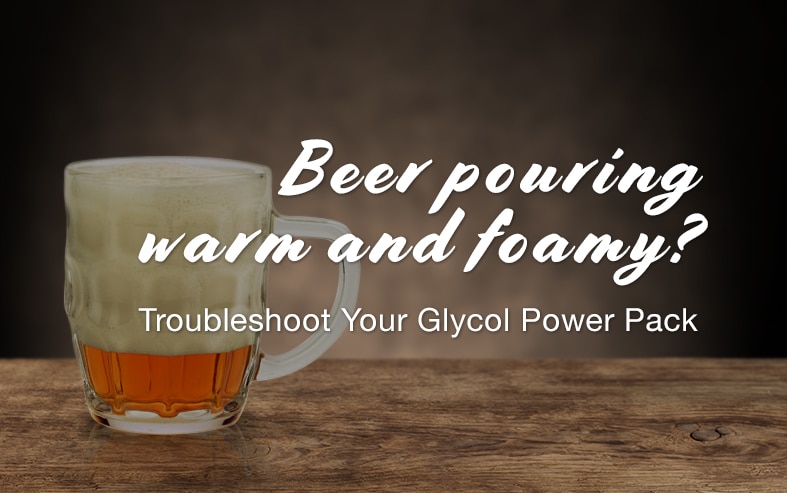Most draft systems use glycol circulation to ensure ideal beer temperature from keg to tap. The main indication of a glycol system problem is that your beer is suddenly pouring warm and foamy.
Determining the Issue
While many reasons can cause beer to pour foamy, temperature issues are the number one culprit. If you confirm the glycol unit is the issue, your next step is determining whom to call. There are two major functions to the glycol power pack, each requiring a different specialist:
Circulation of Glycol – cooled glycol must be physically circulated side-by-side with your beer. This circulation system includes pumps, motors, related parts, and the glycol itself. Any draft maintenance and installation company should be able to work on these parts for you.
Cooling of Glycol – the glycol must be cooled to an appropriate temperature to keep your beer lines cool. This is done by a compressor, just like a refrigerator, and requires a licensed refrigeration technician for maintenance.
So how do you know which part of the system is having problems?
Every glycol power pack should have a temperature read out, or you can use a thermometer if necessary. If the glycol bath temp is in the mid- to low-30s or less, then the problem is likely a bad pump, motor, or pump-motor key. In this case you want to call a draft maintenance company like Leaders Beverage. Basically, the compressor is working, but the pumps aren’t circulating the cold glycol.
The other possibility is that the temp of the glycol bath will be up in the high-30s, 40s, or 50s, even. This means the compressor is having problems and you should call a refrigeration technician.
A Little More About Draft Cooling Systems
There are two kinds of draft systems: direct draw and long draw. With a long draw system (used in most bars and restaurants where the cooler is not immediately adjacent to the tower) there must be a mechanism for keeping the beer cold from the keg all the way to the faucet.
There are two ways to do this. One is by air-cooling, where a fan pushes cold air from the cooler along the enclosed route of the beer lines to the beer tower. The other, best, and most common way of keeping beer cold is with a glycol power pack. Leaders only installs glycol systems, since air-cooled systems are inefficient and have a number of associated problems.
Your glycol power pack should have propylene glycol circulating in it. This is a food-grade anti-freeze; you do not want to use boat, RV, car, or other coolants. While other anti-freeze products are much cheaper than propylene glycol, they aren’t made for glycol power packs and will reduce the life of your machine. They are also poisonous and not food grade.


Beer cold but very foamy
Hi Owen,
From a temperature stand point, use a digital thermometer. The beer in your cooler and the beer after being poured into a glass should be 38 degrees. If the beer comes up in temperature even a few degrees between the cooler and draft tower will cause foam. Carbon Dioxide, Co2, dissolved in the beer is dependent on temperature so if it comes up in temperature from the 38 degrees its programed at the Co2 comes out of solution and thus foam. Glycol is only one of a few things that can cause foaminess. For example, if the pressure on the keg isn’t enough to match the resistance in your system it will pour foamy. If the pour looks like clear beer, foam, clear beer, foam, etc. then the pressure on the keg is to low. Good Luck!